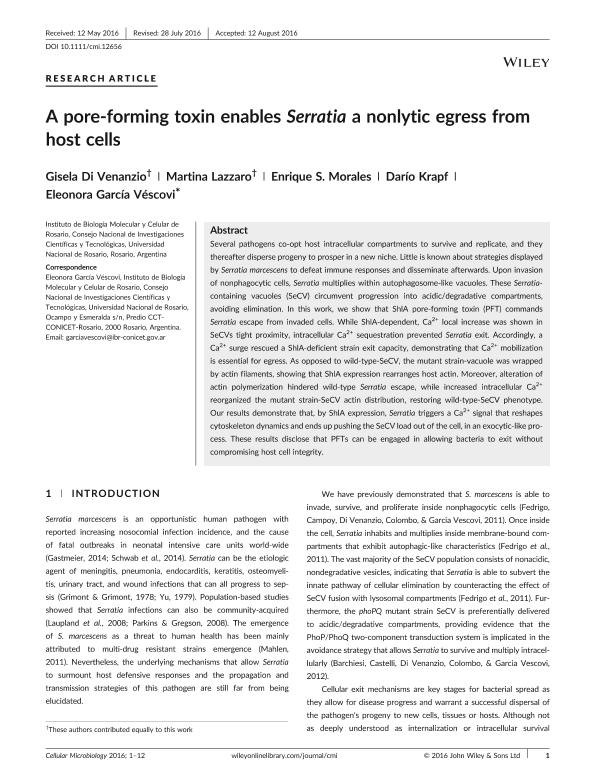Artículo
A pore-forming toxin enables Serratia a nonlytic egress from host cells
Di Venanzio, Gisela Andrea ; Lazzaro, Martina
; Lazzaro, Martina ; Morales, Enrique Salvador
; Morales, Enrique Salvador ; Krapf, Dario
; Krapf, Dario ; Garcia Vescovi, Eleonora
; Garcia Vescovi, Eleonora
 ; Lazzaro, Martina
; Lazzaro, Martina ; Morales, Enrique Salvador
; Morales, Enrique Salvador ; Krapf, Dario
; Krapf, Dario ; Garcia Vescovi, Eleonora
; Garcia Vescovi, Eleonora
Fecha de publicación:
08/2016
Editorial:
Wiley Blackwell Publishing, Inc
Revista:
Cellular Microbiology (print)
ISSN:
1462-5814
Idioma:
Inglés
Tipo de recurso:
Artículo publicado
Clasificación temática:
Resumen
Several pathogens co-opt host intracellular compartments to survive and replicate, and they thereafter disperse progeny to prosper in a new niche. Little is known about strategies displayed by Serratia marcescens to defeat immune responses and disseminate afterwards. Upon invasion of nonphagocytic cells, Serratia multiplies within autophagosome-like vacuoles. These Serratia-containing vacuoles (SeCV) circumvent progression into acidic/degradative compartments, avoiding elimination. In this work, we show that ShlA pore-forming toxin (PFT) commands Serratia escape from invaded cells. While ShlA-dependent, Ca2 + local increase was shown in SeCVs tight proximity, intracellular Ca2 + sequestration prevented Serratia exit. Accordingly, a Ca2 + surge rescued a ShlA-deficient strain exit capacity, demonstrating that Ca2 + mobilization is essential for egress. As opposed to wild-type-SeCV, the mutant strain-vacuole was wrapped by actin filaments, showing that ShlA expression rearranges host actin. Moreover, alteration of actin polymerization hindered wild-type Serratia escape, while increased intracellular Ca2 + reorganized the mutant strain-SeCV actin distribution, restoring wild-type-SeCV phenotype. Our results demonstrate that, by ShlA expression, Serratia triggers a Ca2 + signal that reshapes cytoskeleton dynamics and ends up pushing the SeCV load out of the cell, in an exocytic-like process. These results disclose that PFTs can be engaged in allowing bacteria to exit without compromising host cell integrity.
Palabras clave:
Serratia
,
Pore-Forming Toxin
,
Bacterial Egress
,
Shla
Archivos asociados
Licencia
Identificadores
Colecciones
Articulos(IBR)
Articulos de INST.DE BIOLOGIA MOLECULAR Y CELULAR DE ROSARIO
Articulos de INST.DE BIOLOGIA MOLECULAR Y CELULAR DE ROSARIO
Citación
Di Venanzio, Gisela Andrea; Lazzaro, Martina; Morales, Enrique Salvador; Krapf, Dario; Garcia Vescovi, Eleonora; A pore-forming toxin enables Serratia a nonlytic egress from host cells; Wiley Blackwell Publishing, Inc; Cellular Microbiology (print); 19; 2; 8-2016; 1-12
Compartir
Altmétricas



